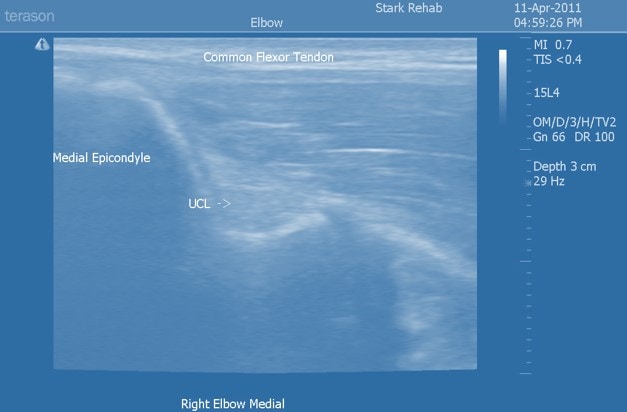More on UCL Tear Recovery: New Study Shows Partial Tears Helped by PRP
UCL tear recovery can be agonizing for an athlete-hopes and dreams dashed by an aggressive surgery and benched for at least a full season. The UCL is the duct tape type ligament that stabilizes the inside of the elbow. I blogged awhile back about how a sports writer complained that many baseball players were failing platelet rich plasma injections for their UCL injuries. One of my concerns was that the orthopedic surgeons injecting these UCL injures with PRP weren’t using guidance and also weren’t able to stress the elbow while observing the UCL under ultrasound, so they couldn’t identify and inject occult tears within the ligament. So what happens when you do this? A recent paper shows that you get high UCL healing success rates! The authors took 34 athletes with partial tears of their UCL ligaments who had been injured for on average 2 months and who had failed conservative care like physical therapy. They then injected these with PRP. They did stress the elbow under ultrasound and so they also measured how much the elbow joint gaped because the UCL ligament was no longer tight. The results? They found that 30/34 athletes (88%) returned to play without the need for any surgery. At about a year and half after the injections, their function scores about doubled and their pain and ability to play dramatically improved. The amount the joint opened on stress ultrasound examination decreased by about 2/3rds toward a more normal amount of joint play. The upshot? Don’t ruin your baseball career with a surgery that may not be needed! All of this is consistent with our elbow UCL experience as well. Partial UCL tears do well with PRP and don’t require surgery and complete tears do better with stem cells. However, blindly trying injecting the UCL with PRP without ultrasound guidance will lead to higher failure rates as has recently been seen in professional athletes.

NOTE: This blog post provides general information to help the reader better understand regenerative medicine, musculoskeletal health, and related subjects. All content provided in this blog, website, or any linked materials, including text, graphics, images, patient profiles, outcomes, and information, are not intended and should not be considered or used as a substitute for medical advice, diagnosis, or treatment. Please always consult with a professional and certified healthcare provider to discuss if a treatment is right for you.

